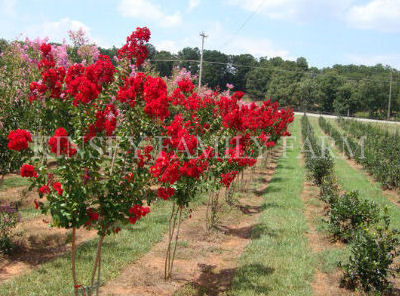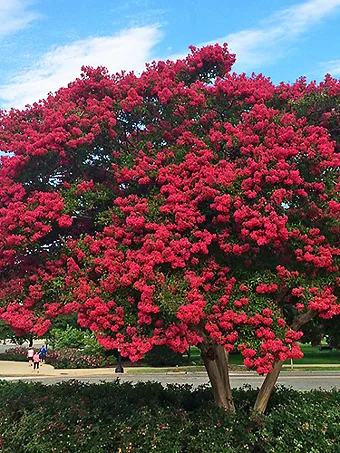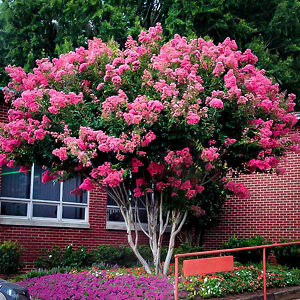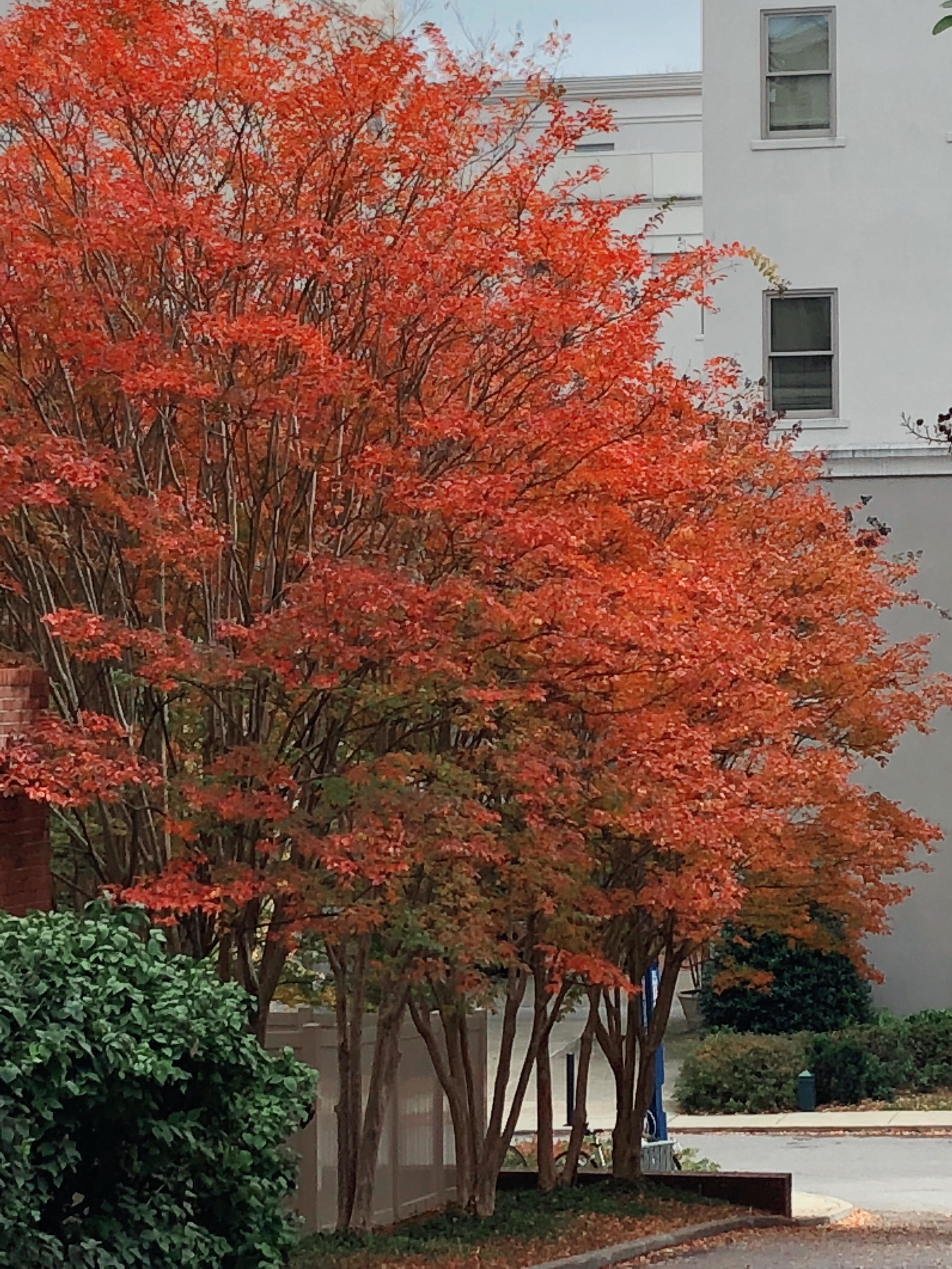
Different Types of Crape Myrtles (Natchez, Dynamite, Etc.): A Complete Guide
Different types of crape myrtles include Natchez, Dynamite, Muskogee, and Tonto. Each variety offers unique colors and growth habits.
Crape myrtles are beloved for their stunning summer blooms and hardy nature. These ornamental trees and shrubs come in various sizes and colors, making them versatile for different landscapes. Natchez crape myrtles boast white flowers and can grow up to 30 feet tall.
Dynamite crape myrtles offer vibrant red blooms and reach about 20 feet in height. Muskogee crape myrtles feature light lavender flowers and grow up to 25 feet. Tonto crape myrtles have bright red flowers and are more compact, growing to about 10-15 feet. Each type adds beauty and charm to gardens and yards.
Introduction To Crape Myrtles
Crape Myrtles are beautiful flowering trees and shrubs. They are popular for their vibrant blooms and hardy nature. These plants add color and charm to any garden or landscape. Let’s explore the different types of Crape Myrtles and their unique features.
Brief History
Crape Myrtles have a rich history. They originated from Asia and were introduced to the United States in the 18th century. Over time, they became a favorite for American gardeners. These plants are celebrated for their long blooming season and stunning colors.
General Characteristics
Crape Myrtles have several distinct features. They are known for their beautiful flowers, which come in various shades such as white, pink, red, and purple. The trees have smooth, peeling bark and can grow in various sizes, from small shrubs to tall trees.
| Type | Height | Flower Color | Blooming Season |
|---|---|---|---|
| Natchez | 20-30 feet | White | Summer to Fall |
| Dynamite | 15-20 feet | Red | Summer |
| Muskogee | 15-20 feet | Lavender | Summer to Fall |
| Sioux | 15-20 feet | Pink | Summer to Fall |
- Natchez: Known for its tall height and white flowers.
- Dynamite: Famous for its vibrant red blooms.
- Muskogee: Noted for its lavender flowers and moderate size.
- Sioux: Appreciated for its pink flowers and medium height.
Crape Myrtles are also drought-tolerant and can thrive in various soil types. They are easy to care for and resistant to many pests. Their adaptability makes them a favorite for many gardeners.

Credit: www.thetreecenter.com
Natchez Crape Myrtle
The Natchez Crape Myrtle is a popular choice for gardeners. It stands out due to its striking features and adaptability. This variety is known for its beautiful white flowers and smooth bark. Let’s dive into its distinct features and ideal growing conditions.
Distinct Features
The Natchez Crape Myrtle is famous for its stunning white blooms. These flowers appear in large clusters, creating a striking visual effect. It blooms from mid-summer to fall, providing extended beauty.
The bark is another notable feature. It has a smooth, cinnamon-colored bark that peels away to reveal a lighter shade underneath. This creates an attractive, multi-colored trunk.
This variety can grow up to 30 feet tall. It often has a wide, spreading canopy. Its large size makes it an excellent choice for creating shade in gardens.
Ideal Growing Conditions
The Natchez Crape Myrtle thrives in full sun. It requires at least six hours of direct sunlight daily.
It prefers well-drained soil. Ensure the soil has good drainage to prevent root rot. Sandy or loamy soils are ideal for this plant.
Watering needs are moderate. Water the plant regularly during its first growing season. Once established, it becomes drought-tolerant.
Pruning helps maintain its shape and encourages new growth. Prune in late winter or early spring before new growth starts.
| Feature | Details |
|---|---|
| Bloom Color | White |
| Bark | Smooth, cinnamon-colored |
| Height | Up to 30 feet |
| Canopy Spread | Wide and spreading |
| Sunlight Needs | Full sun |
| Soil Preference | Well-drained, sandy or loamy |
| Watering | Moderate, drought-tolerant once established |
| Pruning Time | Late winter or early spring |
Dynamite Crape Myrtle
The Dynamite Crape Myrtle is a stunning tree known for its vibrant red blooms. It adds a pop of color to any garden. It is also loved for its ease of care and long blooming season.
Unique Qualities
The Dynamite Crape Myrtle stands out due to its brilliant red flowers. These blooms last from summer to fall. The leaves turn a beautiful orange-red in autumn. This crape myrtle is also resistant to mildew, ensuring healthy growth.
Planting Tips
Follow these tips for planting the Dynamite Crape Myrtle:
- Location: Choose a spot with full sun.
- Soil: Well-drained soil is best.
- Watering: Water deeply after planting.
- Spacing: Space trees 10-15 feet apart.
- Pruning: Prune in late winter or early spring.

Credit: www.thetreecenter.com
Tuscarora Crape Myrtle
The Tuscarora Crape Myrtle is a popular choice for gardeners. It brings vibrant color and elegance to any landscape. This variety is known for its stunning appearance and easy care.
Appearance
The Tuscarora Crape Myrtle boasts beautiful coral pink flowers. These blooms appear in large clusters, creating a striking visual impact. The tree has a rounded crown and can grow up to 20-30 feet tall. Its dark green leaves turn a brilliant orange-red in the fall, adding seasonal interest.
| Feature | Description |
|---|---|
| Flower Color | Coral Pink |
| Height | 20-30 feet |
| Foliage | Dark Green, turns Orange-Red in Fall |
Care Instructions
Caring for a Tuscarora Crape Myrtle is simple. Here are some tips:
- Sunlight: Plant in full sun for best blooms.
- Watering: Water deeply during the first growing season.
- Soil: Prefers well-drained soil.
- Pruning: Prune in late winter to shape and remove dead wood.
- Fertilizing: Use a balanced fertilizer in early spring.
These steps ensure your Tuscarora Crape Myrtle thrives and adds beauty to your garden.
Muskogee Crape Myrtle
The Muskogee Crape Myrtle is a stunning tree known for its lavender blooms. It is a hybrid variety, popular for its long blooming period. This variety can enhance any garden with its vibrant flowers and attractive bark.
Key Traits
- Bloom Color: Lavender
- Height: 15-20 feet
- Spread: 10-15 feet
- Bloom Time: Early summer to fall
- Bark: Smooth, peeling bark with a unique texture
- Foliage: Dark green leaves, turning red-orange in fall
Maintenance Needs
The Muskogee Crape Myrtle is low-maintenance. It thrives in full sun and well-drained soil. Regular watering helps in dry periods, especially for young trees. Pruning is essential to maintain shape and remove dead branches.
- Watering: Moderate, especially during dry spells
- Pruning: Late winter or early spring
- Fertilizing: Use a balanced fertilizer in early spring
- Pest Control: Watch for aphids and mildew
With proper care, the Muskogee Crape Myrtle can be a beautiful addition to any landscape. It offers vibrant color and attractive bark all year round.
Tonto Crape Myrtle
The Tonto Crape Myrtle is a beloved choice for gardeners. Known for its stunning blooms and compact size, it fits perfectly in any garden. Let’s explore why this plant is so special.
Visual Appeal
The Tonto Crape Myrtle boasts vibrant red flowers. These blooms last from summer to fall, adding color to your garden. The leaves turn a brilliant orange-red in the fall, providing a striking contrast.
Here are some key visual features:
- Bloom Color: Bright red
- Bloom Time: Summer to fall
- Fall Foliage: Orange-red
- Bark: Smooth and peeling, revealing a cinnamon-colored underlayer
Growth Requirements
The Tonto Crape Myrtle is easy to grow. It thrives in USDA hardiness zones 7-9. This plant prefers full sun to produce its best blooms.
Here is a table summarizing its growth requirements:
| Requirement | Details |
|---|---|
| Sunlight | Full sun |
| Soil | Well-drained |
| Water | Moderate |
| Hardiness Zones | 7-9 |
- Choose a sunny location.
- Ensure well-drained soil.
- Water regularly but avoid overwatering.
- Fertilize in early spring.
The Tonto Crape Myrtle is a resilient and beautiful choice for any garden.
Crape Myrtle Care
Crape Myrtles are popular for their vibrant blooms and easy maintenance. Proper care ensures they thrive and beautify your garden.
Watering Guidelines
Proper watering is essential for healthy Crape Myrtles. Newly planted trees need frequent watering. Water them deeply twice a week during the first growing season.
Mature Crape Myrtles are drought-tolerant. Water them once a week during dry periods. Avoid overwatering as it can lead to root rot.
Use a soaker hose or drip irrigation for best results. This method ensures water reaches the roots without wetting the foliage.
Pruning Techniques
Pruning helps maintain the shape and health of your Crape Myrtles. The best time to prune is late winter or early spring, before new growth begins.
Remove any dead, damaged, or crossing branches. This encourages better air circulation and reduces disease risk.
For a more compact shape, trim back the tips of the branches. Avoid “topping” or cutting back large branches. This can harm the tree and reduce blooming.
Use clean, sharp tools to make precise cuts. This helps the tree heal quickly and minimizes stress.

Credit: www.hallstewart.com
Pest And Disease Management
Crape Myrtles, such as Natchez and Dynamite, are popular due to their beauty. Yet, they can face pests and diseases. Managing these is crucial for healthy growth. Below, we explore common issues and prevention strategies.
Common Issues
Aphids are tiny insects that suck sap from the leaves. This can cause leaf curling and yellowing.
Powdery Mildew is a fungal disease. It creates a white, powdery coating on leaves and stems.
Japanese Beetles are pests that chew on leaves and flowers. This can leave holes and damage the plant’s appearance.
Black Sooty Mold often grows on the honeydew excreted by aphids. This mold covers leaves and blocks sunlight.
Prevention Strategies
Regular Inspection helps catch problems early. Check leaves, stems, and flowers weekly.
Proper Watering is essential. Water at the base of the plant to avoid wetting the leaves.
Pruning improves air circulation. Remove any dead or diseased branches immediately.
Neem Oil is a natural pesticide. It can control aphids and other pests without harming the plant.
Fungicides can prevent and treat powdery mildew. Apply as directed on the product label.
| Issue | Symptom | Solution |
|---|---|---|
| Aphids | Leaf curling, yellowing | Use Neem Oil |
| Powdery Mildew | White, powdery coating | Apply fungicides |
| Japanese Beetles | Holes in leaves | Handpick or use traps |
| Black Sooty Mold | Black coating on leaves | Control aphids |
- Inspect plants weekly for early signs of pests or diseases.
- Water properly to keep foliage dry.
- Prune regularly to maintain good air circulation.
- Use natural pesticides like neem oil when needed.
- Apply fungicides if fungal diseases are detected.
Frequently Asked Questions
What Are The Different Varieties Of Crepe Myrtles?
Crepe myrtles come in several varieties, including dwarf, semi-dwarf, and standard. Popular types are Natchez, Muskogee, and Sioux. These trees offer a range of colors like pink, red, white, and purple. They are known for their beautiful blooms and hardy nature.
What Is The Difference Between Acoma And Natchez Crape Myrtle?
Acoma crape myrtle has white flowers and grows up to 10 feet tall. Natchez crape myrtle has white flowers and grows up to 30 feet tall. Acoma has a more compact growth habit, while Natchez has a more upright form.
Both are resistant to mildew.
Which Tree Is Better Red Rocket Or Dynamite Crape Myrtle?
Red Rocket crape myrtle grows faster and taller, ideal for larger spaces. Dynamite offers vibrant red flowers and a compact size. Choose based on your space and color preference.
What Kind Of Crape Myrtle Is Natchez?
Natchez is a hybrid crape myrtle known for its white flowers and smooth, exfoliating bark. It grows rapidly, reaching up to 30 feet tall. This variety is highly resistant to mildew and thrives in USDA zones 7-9. It provides year-round interest with its vibrant fall foliage and attractive bark.
Conclusion
Crape myrtles offer beauty and variety to any garden. From Natchez to Dynamite, each type has unique features. These trees provide stunning blooms and require minimal maintenance. Choose the right crape myrtle for your landscape to enjoy vibrant colors and easy care.
Your garden will benefit from these elegant, versatile trees.

